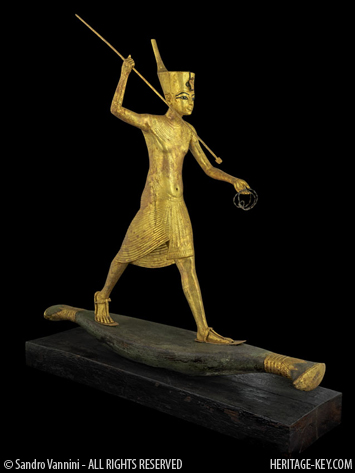 The latest Tut research has revealed a king who, while still in his teens, probably had to walk around with a cane (as seen in this stele), had a cleft palette, suffered from malaria and had a spine that was out of whack. As an Egyptologist told me today, this pretty much kills the idea of King Tut as a sort of warrior king who died in a chariot accident.
The latest Tut research has revealed a king who, while still in his teens, probably had to walk around with a cane (as seen in this stele), had a cleft palette, suffered from malaria and had a spine that was out of whack. As an Egyptologist told me today, this pretty much kills the idea of King Tut as a sort of warrior king who died in a chariot accident.
But for those wanting to see a warrior in the family, you may be interested in another research finding. The new Tut research has confirmed who one set of King Tuts great-grandparents were. And it seems that his great-grandfather did have a military background even though he was not a pharaoh.
Yuya and Thuya were found buried in a private tomb in the Valley of the Kings (KV46) in 1905.Their family line runs like this:
Yuya and Thuya are the parents of Queen Tiye, who in turn is the husband of the pharaoh Amenhotep III, who in turn is thefather of the pharaoh Akhenaten who is (almost definitely) the father of Tut.
Now, you dont get your own tombin the Valley of the Kings unless youre pretty powerful, and these two were certainly no exception. But, while their descendents are household names, Yuya and Thuya are not as well known. You will be hard pressed to find many scholarly articles that discuss these two in depth.
In his book, Whos Who in Ancient Egypt, author Michael Rice describes Yuya as something of a warrior: “[Yuya was] master of the Horse and hence held important military responsibilities. The title Father of the God was conferred on Yuya, and his prestige and standing at court was correspondingly enhanced. When Akhenaten became Crown Prince his power was augmented correspondingly.
Any military responsibilities would have been important. Egypt, at the time they lived, was a powerful Empire with its influence stretching as far as the Euphrates River in Syria.
When the couple died they were buried in KV46 in the Valley of the Kings. The tomb was discovered in 1905 and excavated. Architecturally its quite simple, having a staircase entryway, corridor and burial chamber. The walls are undecorated. Although the tomb was robbed in antiquity, perhaps as many as three times, the sarcophagi and mummies were still intact. Among the remains found were a mummified goose with its head, wingtips and feet removed.
Although I cant post a picture of the mummies themselves due to copyright reasons, I can say that that they are incredibly well preserved right down to the shape of the hair and the detail around the eyes. There has been speculation that Yuya might have been a foreigner in Egypt, although there is no solid evidence to support this.
New Research Results
The new research, carried out by Dr. Zahi Hawass and his team, paints a rather intimate picture of this ancient couple.
Yuya had a long narrow head and long slender fingers, and, for someone who died in his 50s, does not seem to be in chronically bad health. Unlike his unfortunate grandson, he had no club foot, spinal deformationor cleft palette. He did suffer from malaria at some point, but this may not have been what killed him. He alsosuffered from dental problems (very common in Ancient Egypt) and a hernia.
All in all, these are not long-term medical ailments that would have impeded him from a military role. Take away his malaria and hernia, imagine him 20 years younger, and there doesntappear to be a good reason why he couldnt join a modern day army.
His wife on the other hand, King Tuts great-grandmother, was in rough shape. Like her husband she too died at some point in her 50s. She also suffered from a hernia, malaria and dental problems. But Thuya also suffered from severe kyphoscoliosis, which meant that her spine was bent way out of shape. She also had arteriosclerosis, which means that her artery walls were lined up with fat.
Inherited the Wrong Genes?
Their great-grandson, King Tut, seems to have had a run of bad luck when it came to health.To put it bluntly, he was in worseshape in his teens then his great-grandfather was when he was an old man. The Boy King had a Cleft Palate and a mild case of kyphoscoliosis, and his feet were awful, to say the least.He had clubfoot on his left and a condition called Pes Planus on his right, which means that the arch of the foot was collapsed and came in contact with the ground.To make matters worse, hehad a fractured leg.It islikely that hehad to use a cane to get around. With these ailments its pretty hard to see him riding chariots or campaigning far away from home.
To find out more about the family line of King Tut, and the (possibly related) medical conditions suffered by King Tut, watch King Tut Unwrapped on the Discovery Channel, February 21st and 22nd (UK &Europe dates), and check Heritage Key for updates.




